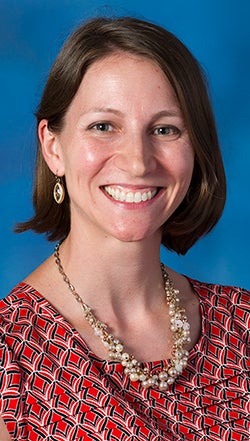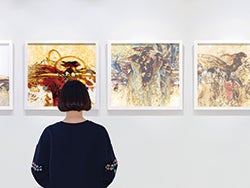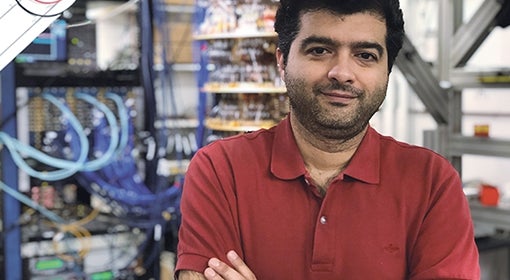It is the first day of a newborn’s life. Mom holds her swaddled baby in her arms. A nurse steps in, suggesting baby’s next feed is overdue. Mom is overwhelmed. Breastfeeding is hard! Must she wake her peacefully sleeping babe?
She turns to her phone to read a semi-automated supportive text she recently received: “Babies are motivated to breastfeed when they feel and smell your skin, especially if they are sleepy babies. You can do skin-to-skin anytime to help jump-start or improve your breastfeeding experience!” Mom unwraps baby and tucks him inside her robe. Baby stirs, and without fully waking, roots for the breast.
Jill Demirci remembers spending most of her time in her first job, as a staff nurse on the mother-baby unit at UPMC Magee-Womens Hospital, helping new moms breastfeed. This surprised Demirci, now assistant professor in the Department of Health Promotion and Development and the Department of Pediatrics. Back then, she assumed breastfeeding came naturally. But now, as a breastfeeding support researcher, she knows there is a universal need for more education and encouragement.
 The MILK texting program aims to do just that. “Have you ever seen another woman breastfeeding?” reads a text sent in week 33 of pregnancy. “Many women haven’t. Join a breastfeeding support group or follow this link for a close-up of how it works.”
The MILK texting program aims to do just that. “Have you ever seen another woman breastfeeding?” reads a text sent in week 33 of pregnancy. “Many women haven’t. Join a breastfeeding support group or follow this link for a close-up of how it works.”
To develop the MILK texts, Demirci and her colleagues had moms use an app to track breastfeeding issues. If, on day three, baby was cranky and seeking to nurse constantly, moms could note that. Researchers used this data to learn what issues arose at what stage. They then developed a text-messaging breastfeeding support program based on those trends. Focus groups with new moms provided feedback on the MILK program, as did consultations with experts in the fields of lactation, media, and marketing. Moms enrolled in the pilot study received texts during pregnancy and until eight weeks postpartum.
MILK texts aren’t fully automated; they follow branch logic, and moms are invited to interact by texting keywords in reply. Moms can also text “help” at any time, and a lactation consultant will contact them. A program like this can allow one lactation consultant to help hundreds of nursing mothers.
Now an IBCLC (International Board Certified Lactation Consultant), when Demirci (NURS ’05, ’10G, ’12G) began her education at Pitt’s School of Nursing, she didn’t realize the possibilities a nursing degree held. During her undergrad coursework, she heard a lecture about breastfeeding and its many benefits, for both mom and baby. “I was so surprised and impressed that a woman’s body can do that!” she says. Although she enjoyed her job as a nurse, Demirci “wanted to do more to influence clinical care,” so she pursued a PhD focusing on breastfeeding support.
Demirci’s research focuses on developing clinical and community-based interventions to help mothers meet their breastfeeding goals. Aside from health communication, like the MILK texts, her studies look at breastfeeding issues exclusive to special populations—like moms of preemies—and understanding and preventing the perception of insufficient milk.
Research in breastfeeding support and lactation is in its infancy, says Demirci, who wrapped up the MILK study of 250 women and is working with colleagues on the results. “There is a lot of folk wisdom but not a lot of research to back it up.”
The American Academy of Pediatrics recommends exclusive breastfeeding for the first six months of a baby’s life and continuing until age one. The World Health Organization recommends continuing until age two. Yet, says Demirci, “many medical school programs don’t touch on breastfeeding support at all.”
She believes educating medical professionals—not only postpartum hospital staff, but other points of contact for new parents like pediatricians and pharmacists—about breastfeeding would likely improve outcomes.
Offering moms more support, through efforts such as the MILK texting program, is essential as well. “Breastfeeding takes time to learn and establish,” says Demirci.
“It works best when moms are relaxed and relying on their babies and their body for cues.
Breakthroughs in the Making
 Show and Tell
Show and Tell
A picture may be worth 1,000 words, but psychology professor John W. Mullennix and researchers at Pitt–Johnstown have found that well-crafted titles can better help viewers understand abstract art. In their study, Mullennix and his team asked viewers to read descriptive or conceptual titles connected to abstract art and then rate their understanding and appreciation of the art. The attention to the art and the type of title affect viewers’ judgments, they concluded. Their results draw awareness to the cognitive processes of art appreciation.
 Sobering News
Sobering News
Want a healthier liver? Get to a warmer climate. People living in colder regions with less sunlight drink more alcohol than their warm-weather counterparts, according to pioneering research from UPMC professor Ramon Bataller and Pitt’s Division of Gastroenterology, Hepatology, and Nutrition. The study, published online in the journal Hepatology, found that as temperature and sunlight hours dropped, alcohol consumption increased. Climate factors also were tied to binge drinking and alcoholic liver disease, a chief cause of mortality in patients with prolonged excessive alcohol use.
 The Great Freeze
The Great Freeze
Imagine a substance that—when mixed into water—raises water’s freezing point from 32 degrees Fahrenheit to about 100 degrees Fahrenheit. For two Pitt professors—John Keith and Sachin Velankar, in the Swanson School of Engineering’s Department of Chemical and Petroleum Engineering—that’s not a dream. They have discovered a liquid polymer which they and their team are optimistic could lead to other mixtures with previously unseen properties and eventually be part of a new class of chemical materials.
This story appeared in the Spring 2019 edition of Pitt Magazine.





